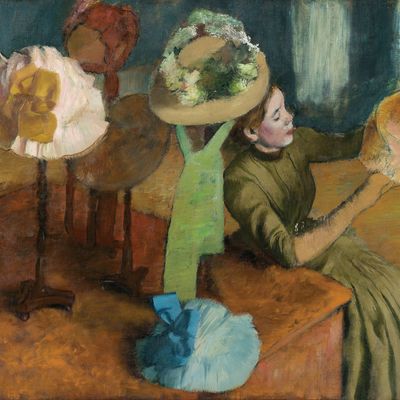
Of all the seismic shocks in Western art, none shook more deeply than French Impressionism. From the 1860s to the 1880s, it was as if a mad bomber were at work in the Parisian art world. The public blowback against the movement was relentless. Established critics and artists were totally opposed to this small band of very young painters. The official art world of the French academy and the general public must have sensed that their entire vocabulary was being dismantled before their astonished angry eyes.
Impressionism covers artists as unalike as ├ëdouard Manet, Claude Monet, Mary Cassatt, Berthe Morisot, Camille Pissarro, Pierre-Auguste Renoir, Edgar Degas, Paul C├®zanne, Fr├®d├®ric Bazille, Gustave Courbet, and Paul Gauguin. Mostly despised in their own lifetimes, they are now among the most famous painters whoÔÇÖve ever lived. Their triumph has been so total, in fact, that Impressionism is now overexposed. ItÔÇÖs considered middlebrow taste, the abracadabra museums use to bring in crowds. From our time, after so many reinventions of art, itÔÇÖs hard to see what the fuss was about.
The Metropolitan Museum of ArtÔÇÖs electrifying ÔÇ£Impressionism, Fashion, and ModernityÔÇØ lets us experience the shock of the new as if for the first time. The conceit of the show is cunningly simple. Using fashion, another misunderstood subject, the show is installed so that you see the style wars of the nineteenth century played out before your eyes. The differences between mediocrity and genius have never been so stark. On one wall might be an academicianÔÇÖs portrait of a woman in a striped showboat of a silk dress. Nearby, from the same time, will be nearly the same subject by an Impressionist. Making matters more scrumptious are more than a dozen spectacular period dresses. We grasp that fashion itself was becoming as radical as painting, that designers were creating their own nonverbal languages. It really was the beginning of what Baudelaire called ÔÇ£the painting of modern life.ÔÇØ
IÔÇÖve seen many of the paintings in this show dozens, even hundreds of times. Yet everything surprises. I expected to find Renoir being his usual overwrought sex-obsessed self; instead, I was in total awe of his insurrectionary ideas about modeling space; his sustained attacks on color, subject, surface. Yes, he still loses focus and fills in backgrounds with fuzzy color, but I will never make the mistake of pooh-poohing Renoir again.
I was also shocked to see how radically Berthe Morisot kept control of her medium and the complex messages she was conveying. The way she uses white turns her works into abstract topographic maps of lacy rain. It is time for a Morisot survey somewhere soon. Degas astonishes, portraying subjects from above, below, closer in, farther away, in mirrors, through keyholes, at odd angles in lamplight, daylight, and candlelight. HeÔÇÖs a monster of pictorial truth and consequence. Manet simply remains a towering god of almost unparalleled pictorial intellect and a skill set so seductive artists still use it. Fr├®d├®ric BazilleÔÇÖs fine planar flatness was likewise a breakthrough: At 29, he died before we could see more.
Which brings us to the most popular painter in Western art history, an artist who probably painted more masterpieces than anyone who has ever lived. In this show, Claude MonetÔÇÖs natural talent, his will, his utter radicalism of technique and vision are in overdrive. It is Monet who is most responsible for codifying what most of us think of as Impressionism. In his hands it became a style, then a second French Revolution.
At the Met, your eyes will tell you exactly what this revolution was. The surfaces of official paintersÔÇöartists like James Tissot and Jean BeraudÔÇöare smooth; all painterly tracks are covered. They are journalistic; stories abound, balance is controlled, lighting is from one direction. Composition is hierarchical, meaning there are more and less important parts of the painting. Shadows are rendered in gray. All these are ways of making it easy for the eye to move across the picture. Although we donÔÇÖt see so much of it here (because of the focus on fashion), these academic paintersÔÇÖ subject matter tended to Greek gods and goddesses, clouds and grottoes, overblown history scenes, saints, and smooth-skinned nudes either doing nothing or having sex with mythic creatures.
Then everything changes. Instead of rendering subjects sculpturally in logical space, Impressionism puts everyday life into spaces that are unclear, interwoven, formless, transitory, knitted together. Light dances across surfaces willy-nilly. Surfaces arenÔÇÖt smooth but are alive with obvious repeating commalike marks. Composition is nonhierarchical; a haystack is as important as the wispy passing cloud, as a furrow in the field. Color is reborn. Rather than being blended, it leads double and triple lives, combining on surfaces in changing shades and then again in the viewerÔÇÖs eyes. Space flattens and flutters; foreground, middle ground, and background blend. Narrative falls away, in favor of uniform, almost hallucinatory, shimmering progressions.
Impressionism not only hails a new kind of paintingÔÇöit represents a leap in the physiology of vision. Our eyes and brains encounter in this work the visual structures of paint, different types of graphic fields, and hugely expanded possibilities for color, surface, and pictorial space. Many mid-nineteenth-century viewers literally could not see this kind of work as painting. Instead they saw incoherent globs of paint. A popular cartoon of the time depicted a Renoir painting of a woman holding a parasol as a flat coin-like oval with an umbrella above it. Painting had metamorphosed into a whole new optical creature. This is where Western art was reborn.
Impressionism, Fashion, and Modernity. Metropolitan Museum of Art. Through May 27.
*This article originally appeared in the April 22, 2013 issue of New York Magazine.

